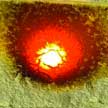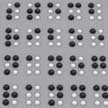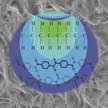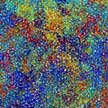Showing Spotlights 105 - 112 of 630 in category All (newest first):
 Magnetic manipulation of nano- and microscale objects is a remote and non-invasive technology with potentially numerous applications in material sciences and life sciences, such as for instance drug delivery. However, a limitation of this technology is that it can only be applied to certain materials with magnetic response, i.e., ferromagnetic or superparamagnetic materials. A new technique allows to incorporate magnetic nanoparticles onto the nonmagnetic skeleton.
Magnetic manipulation of nano- and microscale objects is a remote and non-invasive technology with potentially numerous applications in material sciences and life sciences, such as for instance drug delivery. However, a limitation of this technology is that it can only be applied to certain materials with magnetic response, i.e., ferromagnetic or superparamagnetic materials. A new technique allows to incorporate magnetic nanoparticles onto the nonmagnetic skeleton.
Feb 11th, 2021
 Virtual reality (VR) and augmented reality (AR) are some of the hottest multidisciplinary technology trends right now, integrating computer, various sensor, graphic image, communication, measurement and control multimedia, artificial intelligence, and other technologies. Interactive electronic textiles will provide suitable platforms for VR/AR applications to provide a full range of sensory perceptions. Intrinsic conductive nanomaterials such as carbon nanotubes and metallic nanowires as well as nanoscale devices such as triboelectric nanogenerators are key to developing these electronic textiles.
Virtual reality (VR) and augmented reality (AR) are some of the hottest multidisciplinary technology trends right now, integrating computer, various sensor, graphic image, communication, measurement and control multimedia, artificial intelligence, and other technologies. Interactive electronic textiles will provide suitable platforms for VR/AR applications to provide a full range of sensory perceptions. Intrinsic conductive nanomaterials such as carbon nanotubes and metallic nanowires as well as nanoscale devices such as triboelectric nanogenerators are key to developing these electronic textiles.
Dec 7th, 2020
 Wearable thermal insulation materials for harsh environments always require a compromise during their design and manufacturing. On one hand they need to be mechanically tough to provide impact resistance. On the other hand they need to be heat resistant. Now, researchers have developed a wearable aramid/ceramic aerogel nanocomposite material with both excellent mechanical and thermal properties. The key to this fabrication method is the in situ crosslinking that takes place between the silica pre-ceramic aerogel precursor and the Kevlar fibers.
Wearable thermal insulation materials for harsh environments always require a compromise during their design and manufacturing. On one hand they need to be mechanically tough to provide impact resistance. On the other hand they need to be heat resistant. Now, researchers have developed a wearable aramid/ceramic aerogel nanocomposite material with both excellent mechanical and thermal properties. The key to this fabrication method is the in situ crosslinking that takes place between the silica pre-ceramic aerogel precursor and the Kevlar fibers.
Nov 30th, 2020
 One of the issues with microfluidic devices in life sciences is that most platforms rely on materials or chemicals that are outside the biological breadth as building blocks, scaffolds, or coatings for the devices. In a game-changing approach, researchers are developing a transformative way to fabricate microfluidic devices, where solid walls are replaced by transparent, morphing fluid walls using only biocompatible materials. This novel method can generate cell-friendly microfluidic devices on demand with features below 50 microns in size.
One of the issues with microfluidic devices in life sciences is that most platforms rely on materials or chemicals that are outside the biological breadth as building blocks, scaffolds, or coatings for the devices. In a game-changing approach, researchers are developing a transformative way to fabricate microfluidic devices, where solid walls are replaced by transparent, morphing fluid walls using only biocompatible materials. This novel method can generate cell-friendly microfluidic devices on demand with features below 50 microns in size.
Nov 19th, 2020
 In order to make dynamic written content, for instance a news reader, available for blind or vision-impaired people, scientists have come up with various designs of sheet-type, refreshable Braille displays. Expanding the use of nanotechnologies in designing next-generation Braille readers, researchers now have successfully demonstrated a refreshable Braille display system by using a safe high-voltage power source - a triboelectric nanogenerator.
In order to make dynamic written content, for instance a news reader, available for blind or vision-impaired people, scientists have come up with various designs of sheet-type, refreshable Braille displays. Expanding the use of nanotechnologies in designing next-generation Braille readers, researchers now have successfully demonstrated a refreshable Braille display system by using a safe high-voltage power source - a triboelectric nanogenerator.
Nov 5th, 2020
 Researchers demonstrate that dust-sized photovoltaic cells grown on silicon substrate can be heterogeneously integrated with other chiplets using a high-throughput wafer-level packaging process. The ability to integrate various nanoelectronic chiplets - such as processor, memory, and photovoltaics - in an industrial-scale wafer-level-packaging process, unlocks the potential of large-scale manufacturing of these compact integrated systems with high performance and ultralow cost.
Researchers demonstrate that dust-sized photovoltaic cells grown on silicon substrate can be heterogeneously integrated with other chiplets using a high-throughput wafer-level packaging process. The ability to integrate various nanoelectronic chiplets - such as processor, memory, and photovoltaics - in an industrial-scale wafer-level-packaging process, unlocks the potential of large-scale manufacturing of these compact integrated systems with high performance and ultralow cost.
Oct 27th, 2020
 Being able to replicate the extraordinary mechanical properties of nacre and other biological structures could lead to synthetic materials that possess the exceptional mechanical properties required to perform under extreme conditions. In this context, ultrahigh molecular weight polyethylene is a high-performance specialty polymer with a unique set of properties and applications. It shows remarkable strength-to-weight ratio and an excellent energy absorption ability, making it a promising material for protective applications such as body armor, biomedical implants or heat-resistant coatings.
Being able to replicate the extraordinary mechanical properties of nacre and other biological structures could lead to synthetic materials that possess the exceptional mechanical properties required to perform under extreme conditions. In this context, ultrahigh molecular weight polyethylene is a high-performance specialty polymer with a unique set of properties and applications. It shows remarkable strength-to-weight ratio and an excellent energy absorption ability, making it a promising material for protective applications such as body armor, biomedical implants or heat-resistant coatings.
Oct 22nd, 2020
 Researchers have recently demonstrated that high-intensity focused ultrasound (HIFU) is a promising, non-invasive stimulus with multiple superior and unique capabilities to induce localized heating and achieve temporal and spatial thermal effects in polymers. The team proposes a new manner of stimulating stimuli-responsive polymers. These polymers demonstrate promise for controlled drug delivery, sensing and biosensing, smart coatings, soft robotics, and flexible electronics among others.
Researchers have recently demonstrated that high-intensity focused ultrasound (HIFU) is a promising, non-invasive stimulus with multiple superior and unique capabilities to induce localized heating and achieve temporal and spatial thermal effects in polymers. The team proposes a new manner of stimulating stimuli-responsive polymers. These polymers demonstrate promise for controlled drug delivery, sensing and biosensing, smart coatings, soft robotics, and flexible electronics among others.
Oct 20th, 2020
 Magnetic manipulation of nano- and microscale objects is a remote and non-invasive technology with potentially numerous applications in material sciences and life sciences, such as for instance drug delivery. However, a limitation of this technology is that it can only be applied to certain materials with magnetic response, i.e., ferromagnetic or superparamagnetic materials. A new technique allows to incorporate magnetic nanoparticles onto the nonmagnetic skeleton.
Magnetic manipulation of nano- and microscale objects is a remote and non-invasive technology with potentially numerous applications in material sciences and life sciences, such as for instance drug delivery. However, a limitation of this technology is that it can only be applied to certain materials with magnetic response, i.e., ferromagnetic or superparamagnetic materials. A new technique allows to incorporate magnetic nanoparticles onto the nonmagnetic skeleton.
 Subscribe to our Nanotechnology Spotlight feed
Subscribe to our Nanotechnology Spotlight feed





